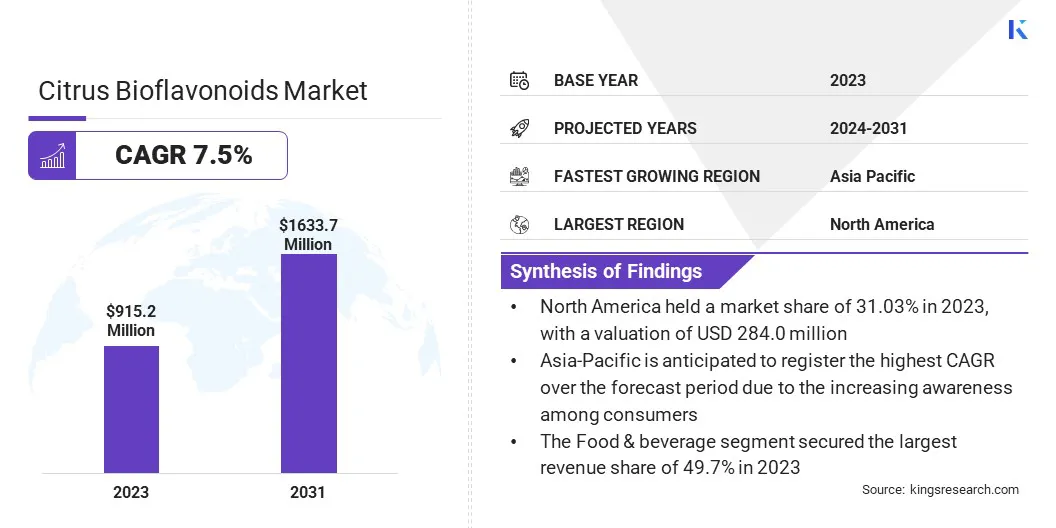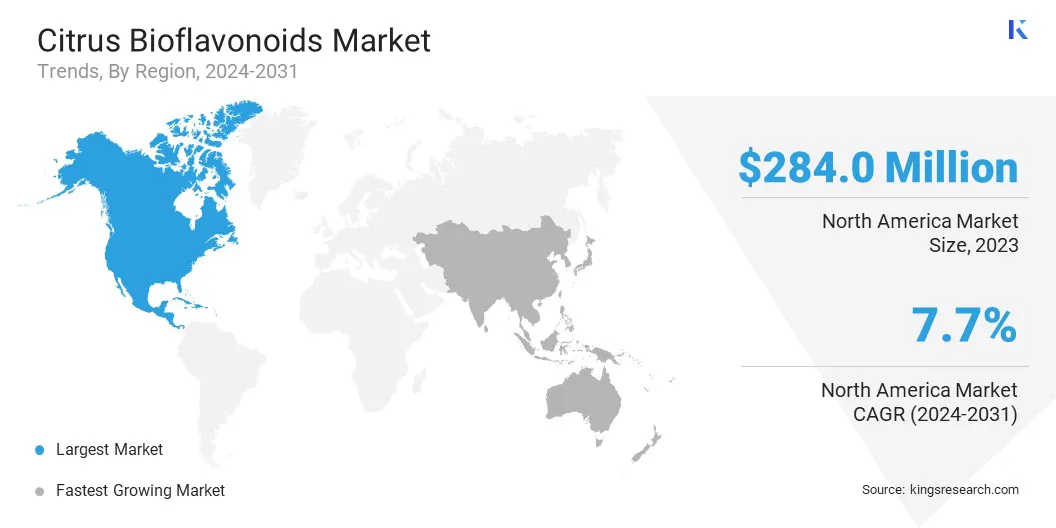Enquire Now
Citrus Bioflavonoids Market Size, Share, Growth & Industry Analysis, By Bioflavonoids Types (Hesperidin, Eriocitrin, Naringin, Diosmin, Others), By Source (Orange & Mandarine), By Application (Food & Beverage Industry, Pharmaceutical Industry, Dietary Supplements Industry, Cosmetic & Personal Care Industry) and Regional Analysis, 2024-2031
Pages: 120 | Base Year: 2023 | Release: April 2024 | Author: Ashim L.
Key strategic points
The global Citrus Bioflavonoids Market size was valued at USD 915.2 million in 2023 and is projected to reach USD 1633.7 million by 2031, growing at a CAGR of 7.5% from 2024 to 2031. In the scope of work, the report includes products offered by companies such as Nature LLC, Solgar Inc., Freeda Vitamins Inc., NOW® Foods, Nans Products, Natural Factors USA, BOC Sciences., Country Life, LLC., Merck KGaA, Cayman Chemical and Others.
This growth is fueled by increasing consumer awareness about the health benefits of these natural compounds and the rising demand for natural ingredients in various industries, including pharmaceuticals and cosmetics. The growing trend of clean label products and the shift toward organic and plant-based ingredients are also contributing to market expansion.
Additionally, surging research and development activities in the field of citrus bioflavonoids are expected to create new opportunities for the citrus bioflavonoids market growth in the coming years.
Furthermore, mountingconsumer awareness surrounding the health benefits associated with these natural compounds is contributing to the growth of the market. The market shows consistent growth in the regions that have a high production of citrus fruits, including South America, Europe, and Asia Pacific.
Additionally, regulatory bodies also play a pivotal role in shaping the market dynamics by imposing stringent guidelines regarding the utilization of citrus bioflavonoids across various industries. Moreover, there is a notable shift toward organic and natural products, which is driving the demand for citrus bioflavonoids in sectors such as food and beverage, pharmaceuticals, and cosmetics.
Citrus bioflavonoids are a group of plant compounds known for their antioxidant properties and are commonly found in citrus fruits. In the food and beverage industry, they are frequently utilized as natural additives to enhance flavor and color.
Beyond their antioxidant properties, citrus bioflavonoids have been associated with potential health benefits, including reducing inflammation and improving immune function. Government agencies regulate the use of citrus bioflavonoids to ensure adherence to safety and quality standards.
Additionally, as research continues to explore their potential benefits and applications, the utilization of citrus bioflavonoids is expected to expand across various industries. Overall, citrus bioflavonoids have the potential to revolutionize our perception of natural additives and their impact on our health and well-being.

The surge in demand for citrus bioflavonoids is attributed to growing consumer awareness regarding the health benefits of natural supplements. Citrus bioflavonoids, derived from citrus fruits, are recognized for their antioxidant properties and their ability to support overall health.
As individuals seek natural alternatives to conventional medications, the citrus bioflavonoids market is experiencing substantial growth. Furthermore, the expansion of the health and wellness industry has intensified the demand for these supplements as consumers seek natural methods to enhance their well-being.
With their established benefits in boosting the immune system and reducing inflammation, citrus bioflavonoids have become a favored choice for individuals aiming to improve their overall health. Moreover, high consumer focus on maintaining a healthy lifestyle has contributed to the increased interest in natural supplements such as citrus bioflavonoids.
As ongoing research continues to affirm the effectiveness of these supplements, the demand for citrus bioflavonoids is expected to increase in the future. In addition to this, rising consumer inclination toward natural remedies and preventive healthcare is driving the growth of the market as more individuals prioritize their well-being.
The citrus bioflavonoids marketis growing rapidly in the upcoming years, primarily driven by the increasing consumer awareness regarding the health benefits associated with these natural compounds. Additionally, a surge in the demand for citrus bioflavonoids due to their antioxidant properties and potential to enhance immune health.
In response to this growing demand, manufacturers in the market are focusing on product innovation and development to meet the diverse needs of various industries, including pharmaceuticals, food and beverages, and cosmetics. In order to effectively capitalize on this expanding market, manufacturers are adopting a key strategy of emphasizing the organic and natural origins of their citrus bioflavonoid products.
As consumers become more health-conscious and environmentally aware, there is a growing preference for products that are free from synthetic chemicals and pesticides. To leverage this trend, manufacturers are highlighting the natural sourcing of their products to differentiate themselves in the market and attract a larger customer base. This strategy is helping them build trust and credibility among consumers and increasing brand loyalty and repeat purchases.
However, the high production costs associated with sourcing and extracting citrus bioflavonoids have been a major hindrance to the growth of the market. These costs include expenses for harvesting, processing, and transporting the raw materials needed for bioflavonoid production.
As a result, many companies in the industry are finding it difficult to maintain competitive pricing and meet consumer demand. This, in turn, is limiting the market potential for expansion and innovation. Some smaller producers have had to scale back operations or even shut down entirely due to the financial strain of high production costs.
Additionally, the lack of cost-effective solutions for bioflavonoid extraction has further exacerbated the issue, making it challenging for companies to improve efficiency and reduce expenses. Nevertheless, manufacturers are actively engaging with and overcoming the challenges associated with production costs.
This proactive approach is crucial for their sustainability and to fully leverage market opportunities, thereby ensuring they realize their maximum potential in the competitive landscape. This involves strategic cost management, optimizing operational efficiencies, and innovative product development, all aimed at enhancing profitability and market positioning.
Emerging trends within the citrus bioflavonoids market are primarily characterized by a surge in consumer preference for natural and botanical ingredients within the food and beverage sector. This shift is largely attributed to mounting awareness regarding the health advantages associated with citrus bioflavonoids, including their antioxidant and anti-inflammatory properties.
Furthermore, rising incidences of lifestyle-induced ailments, such as cardiovascular diseases and cancer, are propelling the demand for citrus bioflavonoids across dietary supplements and nutraceuticals. Another significant market trend is the emphasis on sustainability and ethical procurement practices impelled by the increasing consumer inclination toward understanding the environmental and societal implications of their consumption patterns.
Corporations are progressively gravitating toward suppliers committed to sustainable and ethical production methodologies for citrus bioflavonoids. This transition not only aligns with consumer expectations for transparency and ethical responsibility but also contributes to environmental conservation and community support.
The burgeoning interest in citrus bioflavonoids is fostering a more mindful and health-centric orientation in the dietary supplement and nutraceutical industry.
The global market is segmented based on bioflavonoids types, source, application, and geography.
Based on bioflavonoids types, the citrus bioflavonoids market is segmented into hesperidin, eriocitrin, naringin, diosmin, and others. The hesperidin segment led the market with a revenue share of 37.5% in 2023, due to its numerous health benefits and versatile applications. This compound has been studied extensively for its antioxidant properties, which help protect cells from damage caused by free radicals.
Additionally, hesperidin has been shown to have anti-inflammatory effects, which has made it a popular choice for those looking to support their overall health and well-being. Its wide availability in various citrus fruits such as oranges, lemons, and grapefruits also contributes to its prevalence in the market.
Furthermore, hesperidin has been linked to improved cardiovascular health, making it a sought-after ingredient in supplements and functional foods aimed at promoting heart health.
Based on source, the market is bifurcated into orange & mandarine, lemon, and grapes. The orange & mandarine segment secured the largest revenue share of 54.7% in 2023, as these fruits are widely recognized for their high levels of citrus bioflavonoids, which are known for their antioxidant properties and health benefits.
Additionally, the popularity of orange and mandarin flavors in various food and beverage products has contributed to their widespread use. Moreover, the versatility of these fruits in both fresh and processed forms makes it a preferred choice for manufacturers looking to incorporate bioflavonoids into their products. Strong consumer demand for natural and healthy ingredients is further fueling the growth of orange and mandarin segments in the citrus bioflavonoids market.
Based on application, the market is bifurcated into food & beverage, pharmaceutical, dietary supplements, and cosmetic & personal care. The Food & beverage segment secured the largest revenue share of 49.7% in 2023; due to the increasing consumer preference for natural and healthy ingredients in their diet. Citrus bioflavonoids, known for their antioxidant properties, are a popular choice for manufacturers seeking to enhance the nutritional value of their products.
Additionally, the versatility of citrus bioflavonoids allows for their easy incorporation into a wide range of food and beverage products by the growing awareness among consumers about the health benefits of citrus bioflavonoids is further aiding segment progress.
Based on region, the global market is classified into North America, Europe, Asia-Pacific, MEA, and Latin America.

North America Citrus Bioflavonoids Market share stood around 31.03% in 2023 in the global market, with a valuation of USD 284.0 million. The region possesses extensive agricultural lands and employs advanced farming techniques. As a result, the region consistently produces high-quality citrus fruits that are rich in bioflavonoids.
Moreover, the robust infrastructure and efficient distribution networks in North America facilitate the easy transportation of citrus products, giving them a competitive advantage in the global market. Furthermore, growing research and innovation in the region in the field of agriculture has played a pivotal role in bolstering regional market growth.
With continuous advancements, research & development in agricultural technology, and a steadfast commitment to meeting consumer preferences, North America is well-positioned to maintain its leadership in the global citrus bioflavonoids market through the review period.
Asia-Pacific is anticipated to register the highest CAGR over the forecast period due to the increasing awareness among consumers in this region about the numerous health benefits associated with citrus bioflavonoids. As individuals in Asia-Pacific become more health-conscious and seek natural ways to enhance their well-being, there has been a significant surge in the demand for citrus bioflavonoids.
Furthermore, the large population and rising disposable income levels have played a pivotal role in driving regional market growth. Moreover, the escalating prevalence of chronic diseases in the Asia-Pacific has further fueled the demand for citrus bioflavonoids in the region, driving the growth of the regional market.
The global citrus bioflavonoids market report will provide valuable insight with an emphasis on the fragmented nature of the industry. Prominent players are focusing on several key business strategies such as partnerships, mergers and acquisitions, product innovations, and joint ventures to expand their product portfolio and increase their market shares across different regions.
Strategic initiatives, including investments in R&D activities, the establishment of new manufacturing facilities, and supply chain optimization, could create new opportunities for the market growth.
By Bioflavonoids Types
By Source
By Application
By Region
Frequently Asked Questions